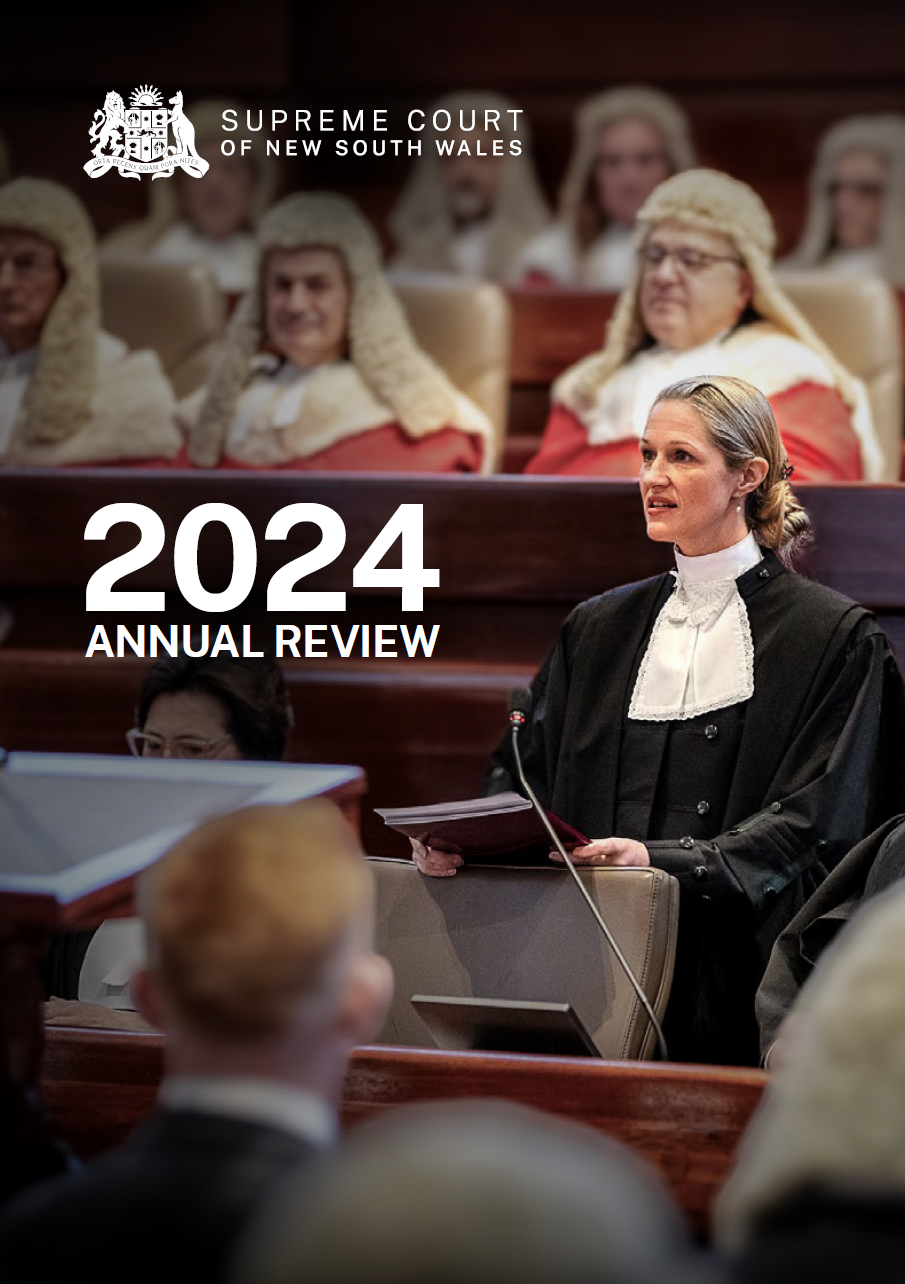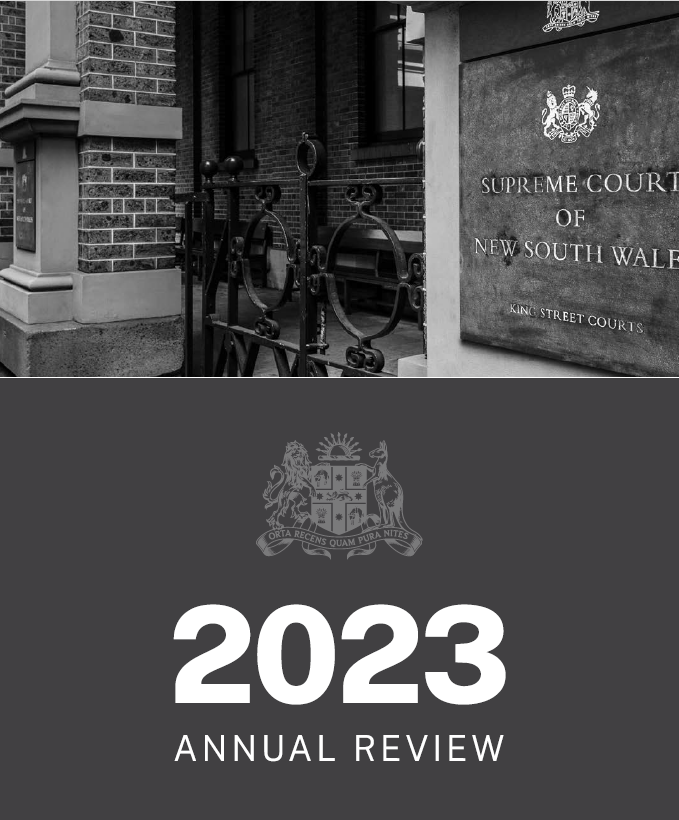Automatic language translation
Our website uses an automatic service to translate our content into different languages. These translations should be used as a guide only. See our Accessibility page for further information.
I am pleased to present the 2024 Annual Review of the Supreme Court of New South Wales. Its purpose is to provide an overview of the Court’s work over the previous year, both in qualitative and quantitative terms.
2024 was a year of great significance in the Court’s history as the Court marked the bicentenary of the proclamation of the Third Charter of Justice and the first sitting of the Court under our first Chief Justice, Sir Francis Forbes, on 17 May 1824.
The court system in New South Wales is structured on a hierarchical basis. The Supreme Court is a superior court of record and, as such, has an inherent jurisdiction in addition to its specific statutory jurisdiction.
Learn more about the jurisdiction of the Supreme Court, its judges, and registrars.
The Court of Appeal was established in 1966 as Australia’s first intermediate appellate Court. It hears appeals in civil matters against the decisions of the judicial officers of the Supreme Court, other courts, and tribunals within the State. It also determines applications for judicial review. Its judgments are routinely cited around the nation and by foreign courts.
The Court of Criminal Appeal is the State’s highest court for criminal matters. A person who has been convicted or who pleaded guilty and been sentenced by a Supreme Court or District Court judge, may appeal to the Court of Criminal Appeal. Appeals may also be brought from decisions of the Land and Environment Court in its criminal jurisdiction.
Judges of the Common Law Division hear the most serious indictable offences in New South Wales. These matters include homicide, terrorism and other offences for which the penalty may include life imprisonment. Other matters involving serious criminality or matters of public interest may be brought before the Court with the Chief Justice’s approval. They also deal with serious personal injury and contractual matters, defamation, actions for possession, professional negligence suits and claims for compensation arising out of institutional abuse.
The Equity Division exercises the traditional equity jurisdiction, dealing with claims for remedies other than damages and recovery of debts. The Division’s work includes cases arising from contractual actions or rights of property, and disputes relating to partnerships, trusts or deceased estates.
Learn more about the jurisdictions and operations of the Supreme Court and its divisions.
Delays are measured by the time between the establishment of readiness for hearing and the first group of available hearing dates that the Court offers for criminal and civil trial cases, criminal and civil appeals and bail applications. These delays do not apply if the Court orders an expedited hearing.
The Supreme Court supports mediation as a method of alternative dispute resolution for civil proceedings. Litigants in any contested civil case (including appeals) can consider using mediation. Mediation is generally inapplicable for cases where no defendant contests the claim, applications for an uncontested grant of probate, adoption of children, winding-up of companies, proceeds of crime cases and for miscellaneous applications where only administrative processing is required. For other civil cases mediation is considered generally applicable, although individual cases may have circumstances that make mediation inadvisable or inappropriate.
The Costs Assessment Scheme is the mechanism through which clients and practitioners can resolve disputes about costs and quantify costs orders made by New South Wales courts and tribunals.
Since the twelfth century, it has been customary for advocates to swear an oath of allegiance upon admission to practice. The Third Charter of Justice provided for the formation of the Supreme Court of New South Wales, the appointment of court officers and the admission of solicitors and barristers.
Learn about the Supreme Court's role in the admission of lawyers in NSW.
The Law Courts Library is one of the premier law libraries in Australia; elements of its collection predate the formation of the Supreme Court in 1824. The library is a legal resource and information centre for all judicial officers, court staff and registrars of the various courts in the Law Courts Building.
The Supreme Court’s long-standing commitment to open justice is reflected in the support given to journalists covering its proceedings.
In 2024 the Court’s media unit responded to approximately 8,500 enquiries, including more than 1000 file access requests, from 210 individual journalists, producers and podcasters.
The Supreme Court established the Pro Bono Scheme in 2001 with support from the New South Wales Bar Association and Law Society of New South Wales.
The Scheme operates in accordance with Part 7 Division 9 of the Uniform Civil Procedure Rules 2005 and enables unrepresented litigants to be referred to a barrister and/or solicitor once the Court determines that it is in the interests of the administration of justice for a referral to be made.
Judicial speaking engagements, conferences, publications and appointments to legal, cultural or benevolent organisations.

The full 2024 Annual Review is available in PDF.
I am pleased to present the Supreme Court of New South Wales’ Annual Review for 2023.
During 2023, the Court welcomed 6 new judges, Justices Weinstein, Sweeney, Stern, Nixon, McGrath and Huggett, all of whom brought vast experience (including in the cases of Justice Weinstein, Sweeney and Huggett, judicial experience) to the Bench in a range of areas.
The court system in New South Wales is structured on a hierarchical basis The Supreme Court is the superior court of record in New South Wales and,as such, has an inherent jurisdiction in addition to its specific statutory jurisdiction.
Learn more about the jurisdiction of the Supreme Court, its judges, and registrars.
The Court of Appeal was established in 1966 as Australia’s first intermediate appellate Court. It hears appeals in civil matters against the decisions of the judicial officers of the Supreme Court, other courts, and tribunals within the State. It also determines applications for judicial review. Its judgments are routinely cited around the nation and by foreign courts.
The Court of Criminal Appeal is the State’s highest court for criminal matters. A person who has been convicted or who pleaded guilty and been sentenced by a Supreme Court or District Court judge, may appeal to the Court of Criminal Appeal. Appeals may also be brought from decisions of the Land and Environment Court in its criminal jurisdiction.
Judges of the Common Law Division hear the most serious indictable offences in New South Wales. These matters include homicide, terrorism and other offences for which the penalty may include life imprisonment. Other matters involving serious criminality or matters of public interest may be brought before the Court with the Chief Justice’s approval. They also deal with serious personal injury and contractual matters, defamation, actions for possession, professional negligence suits and claims for compensation arising out of institutional abuse.
The Equity Division exercises the traditional equity jurisdiction, dealing with claims for remedies other than damages and recovery of debts. The Division’s work includes cases arising from contractual actions or rights of property, and disputes relating to partnerships, trusts or deceased estates.
Learn more about the jurisdictions and operations of the Supreme Court and its divisions.
The Supreme Court supports mediation as a method of alternative dispute resolution for civil proceedings. Litigants in any contested civil case (including appeals) can consider using mediation. Mediation is generally inapplicable for cases where no defendant contests the claim, applications for an uncontested grant of probate, adoption of children, winding-up of companies, proceeds of crime cases and for miscellaneous applications where only administrative processing is required. For other civil cases mediation is considered generally applicable, although individual cases may have circumstances that make mediation inadvisable or inappropriate.
Delays are measured by the time between the establishment of readiness for hearing and the first group of available hearing dates that the Court offers for criminal and civil trial cases, criminal and civil appeals and Bails List cases. These delays do not apply if the Court orders an expedited hearing or for matters in the Commercial List of the Equity Division.
The Costs Assessment Scheme is the mechanism through which clients and practitioners can resolve disputes about costs and also quantify costs orders made by New South Wales courts and tribunals.
The Law Courts Library is one of the premier law libraries in Australia; elements of its collection predate the formation of the Supreme Court in 1824. The library is a legal resource and information centre for all judicial officers, court staff and registrars of the various courts in the Law Courts Building.
In 2024, the Supreme Court will celebrate the bicentenary of its founding under the New South Wales Act 1823 and the Third Charter of Justice, in conjunction with the Sheriff’s Office and the Legislative Council of NSW. The Court will publish an illustrated book, commission a gallery and interpretive history wall, host seminars and organise tours by legal studies students and members of the public. Together, these endeavours will situate the Court in the great social and political developments of the last two centuries, such as the Frontier Wars, the Gold Rush, federation, the Great Depression and two world wars. This outreach by the Supreme Court will be supported by the media unit through its dedicated bicentenary projects officer, as well as its website and social media accounts, and contacts in the mainstream media.
Since the twelfth century it has been customary for advocates to swear an oath of allegiance upon admission to practice. The Third Charter of Justice provided for the formation of the Supreme Court of New South Wales, the appointment of court officers and the admission of solicitors and barristers. Among the first cohort of lawyers to be admitted in 1824 were barristers Saxe Bannister, Dr Wardell and William Charles Wentworth.
Learn about the Supreme Court's role in the admission of lawyers in NSW.
The Pro Bono Scheme operates in accordance with Part 7 Division 9 of the Uniform Civil Procedure Rules 2005 and enables unrepresented litigants to be referred to a barrister and/or solicitor once the Court determines that it is in the interests of the administration of justice for a referral to be made.
Judicial speaking engagements, conferences, publications and appointments to legal, cultural or benevolent organisations. Read more.

The full 2023 Annual Review is available in PDF.
Last updated: